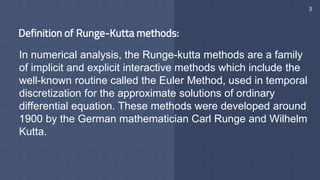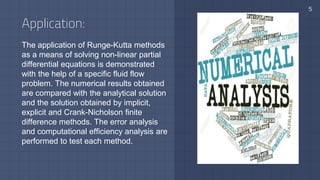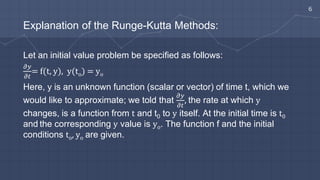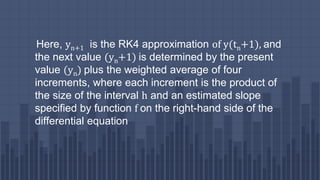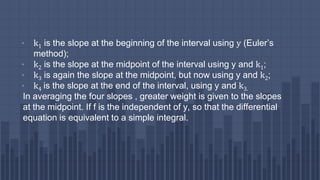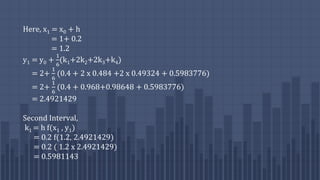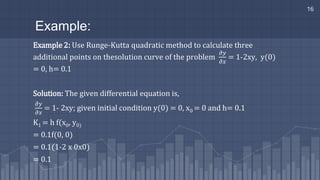Runge-Kutta methods with examples
- 2. Academic Description Presenter Details: Md. Sajjad Hossain Id: 18010101 Md. Shoheal Hossan Id: 18010125 Tasmia Kamal Id: 18010126 5th semester ,31st batch, CSE Course title: Numerical Analysis Course Code: CSE 311 Course Teacher: Wahidul Alam Sr. Lecturer, CSE, FSET, USTC. University of Science and Technology Chittagong Department of Computer Science and Engineering 2
- 3. Definition of Runge-Kutta methods: In numerical analysis, the Runge-kutta methods are a family of implicit and explicit interactive methods which include the well-known routine called the Euler Method, used in temporal discretization for the approximate solutions of ordinary differential equation. These methods were developed around 1900 by the German mathematician Carl Runge and Wilhelm Kutta. 3
- 4. The most widely known member of the Runge-Kutta family is generally referred to as “RK4”, “Classic Runge- Kutta method or simply as “the Runge-Kutta method.
- 5. Application: The application of Runge-Kutta methods as a means of solving non-linear partial differential equations is demonstrated with the help of a specific fluid flow problem. The numerical results obtained are compared with the analytical solution and the solution obtained by implicit, explicit and Crank-Nicholson finite difference methods. The error analysis and computational efficiency analysis are performed to test each method. 5
- 6. Explanation of the Runge-Kutta Methods: Let an initial value problem be specified as follows: 𝜕𝑦 𝜕𝑡 = f(t, y), y(to) = yo Here, y is an unknown function (scalar or vector) of time t, which we would like to approximate; we told that 𝜕𝑦 𝜕𝑡 , the rate at which y changes, is a function from t and t0 to y itself. At the initial time is t0 and the corresponding y value is yo. The function f and the initial conditions to, yo are given. 6
- 7. Now pick a step-size h>0 and define yn+1 = yn + 1 6 (k1+2k2+2k3+k4); tn+1= tn + h for n=0, 1, 2, 3,…. Using k1= hf(tn,yn) k2= hf(tn+ ℎ 2 , yn+ k1 2 ) k3= hf(tn+ ℎ 2 , yn+ k2 2 ) k4= hf(tn+h, yn + k3)
- 8. Here, yn+1 is the RK4 approximation of y(tn+1), and the next value (yn+1) is determined by the present value (yn) plus the weighted average of four increments, where each increment is the product of the size of the interval h and an estimated slope specified by function f on the right-hand side of the differential equation
- 9. • k1 is the slope at the beginning of the interval using y (Euler’s method); • k2 is the slope at the midpoint of the interval using y and k1; • k3 is again the slope at the midpoint, but now using y and k2; • k4 is the slope at the end of the interval, using y and k3. In averaging the four slopes , greater weight is given to the slopes at the midpoint. If f is the independent of y, so that the differential equation is equivalent to a simple integral.
- 11. Example: Example 1: Using Runge-Kutta method Solve y’ = xy for x= 1.4. Initially x = 1, y=2 (take h= 0.2) Solution: The given differential equation is, 𝜕𝑦 𝜕𝑡 = f(x, y) = x y Given that x0 = 1, y0 = 2, and h= 0.2 First interval: K1 = h f(x0, y0) = 0.2 f(1,2) = 0.2 (1 x 2) = 0.4 11
- 12. k2 = h f(x0 + ℎ 2 , y0 + k1 2 ) = 0.2 f(1.1 , 2.2) = 0.2 (1.1 x 2.2) = 0.484 k3 = h f(x0 + ℎ 2 , y0 + k2 2 ) = 0.2 f(1.1 , 2.242) = 0.2 (1.1 x 2.242) = 0.49324 k4 = h f(x0 + ℎ , y0 + k3) = 0.2 f(1.1 , 2.49324) = 0.2 (1.1 x 2.49324 ) = 0.5983776 x0 + ℎ 2 = 1+ 0.2 2 = 1.1 y0 + k1 2 = 2+ 0.4 2 = 2.2 y0 + k2 2 = 2 + 0.484 2 = 2.242 x0 + h =1+ 0.2 = 1.2 y0 + k3= 2 + 0.49324 = 2.49324
- 13. Here, x1 = x0 + h = 1+ 0.2 = 1.2 y1 = y0 + 1 6 (k1+2k2+2k3+k4) = 2+ 1 6 (0.4 + 2 x 0.484 +2 x 0.49324 + 0.5983776) = 2+ 1 6 (0.4 + 0.968+0.98648 + 0.5983776) = 2.4921429 Second Interval, k1 = h f(x1 , y1) = 0.2 f(1.2, 2.4921429) = 0.2 ( 1.2 x 2.4921429) = 0.5981143
- 14. k2 = h f(x1 + ℎ 2 , y1 + k1 2 ) = 0.2 f(1.3 , 2.7911999) = 0.2 (1.3 x 2.7911999) = 0.725712 k3 = h f(x1 + ℎ 2 , y1 + k2 2 ) = 0.2 f(1.3 , 2.8549989) = 0.2 (1.3 x 2.8549989) = 0.7422997 k4 = h f(x1 + ℎ , y1 + k3) = 0.2 f(1.1 , 3.2344426) = 0.2 (1.1 x 3.2344426) = 0.9056439 x1 + ℎ 2 = 1.2+ 0.2 2 = 1.3 y1 + k1 2 = 2.4921429+ 0.5981143 2 = 2.7911999 y1 + k2 2 = 2.4921429 + 0.725712 2 = 2.8549989 x1 + h =1.2+ 0.2 = 1.4 y1 + k3= 2.4921429 + 0.7422997 = 3.2344426
- 15. Since, x2 = x1 + h = 1.2 +.2 = 1.4 and, y2 = y1 + 1 6 (k1+2k2+2k3+k4) = 2.4921429 + 1 6 ( 0.5981143 +1.451424 + 1.4845994 + 0.9056439) = 3.2321065 The value of x and y can be tabularized by: x 1 1.2 1.4 y 2 2.4921429 3.2321065
- 16. Example: Example 2: Use Runge-Kutta quadratic method to calculate three additional points on thesolution curve of the problem 𝜕𝑦 𝜕𝑥 = 1-2xy, y(0) = 0, h= 0.1 Solution: The given differential equation is, 𝜕𝑦 𝜕𝑥 = 1- 2xy; given initial condition y(0) = 0, x0 = 0 and h= 0.1 K1 = h f(x0, y0) = 0.1f(0, 0) = 0.1(1-2 x 0x0) = 0.1 16
- 17. k2 = h f(x0 + ℎ 2 , y0 + k1 2 ) = 0.1f(0+ 0.1 2 , 0+ 0.1 2 ) = 0.1 f(0.05 , 0.05) = 0.1 (1- 2 x0.05 x0.05) = 0.0995 k3 = h f(x0 + ℎ 2 , y0 + k2 2 ) = 0.1f(0.05, 0+ 0.0995 2 ) = 0.1 f(0.5 , 0.04975) = 0.1 (1- 2 x0.05 x 0.04975) = 0.0995025
- 18. k4 = h f(x0 + ℎ , y0 + k3) = 0.1 f(0.1 , 0.0995025) = 0.2 (1-2x 0.1 x 0.0995025) = 0.09801 X1 = x0 + h = 0 + 0.1 = 0.1 Since, y1 = y0 + 1 6 (k1+2k2+2k3+k4) = 0 + 1 6 ( 0.1 +2x 0.0995 + 2 x 0.0995025 + 0.09801) = 1 6 ( 0.1 + 0.199 + 0.199005 + 0.09801) = 0.0993358 = 0.099336
- 19. The value of x and y can be tabularized by: x 0 0.1 y 0 0.99336
- 20. Algorithm (Runge-Kutta) Method of order 4 20
- 21. References: ▫ Text book: Numerical Analysis by A.R. Vasishtha and Vipin Vasishtha ▫ https://en.wikipedia.org/wiki/Runge%E2%80%93Kutta_methods ▫ https://www.quora.com/What-are-the-applications-of-the-Runge- Kutta-method-in-real-life-based 21
- 22. Ask frequently, if you have any QUESTION???


